Sourdough Cinnamon Raisin English Muffins Recipe
This post may contain affiliate links. As an Amazon Associate, I may receive a small commission, at no cost to you, if you make a purchase. Please read our disclosure policy.
Sourdough cinnamon raisin English muffins are studded with plump raisins in a tangy, cinnamon-flavored muffin. You’re sure to love these light and fluffy sourdough English muffins.
Homemade English muffins are so easy to make that you’ll wonder why you didn’t make them sooner. Plus, there’s no need for any special equipment like a bread machine or stand mixer, this dough mixes easily with a bowl and a spoon.
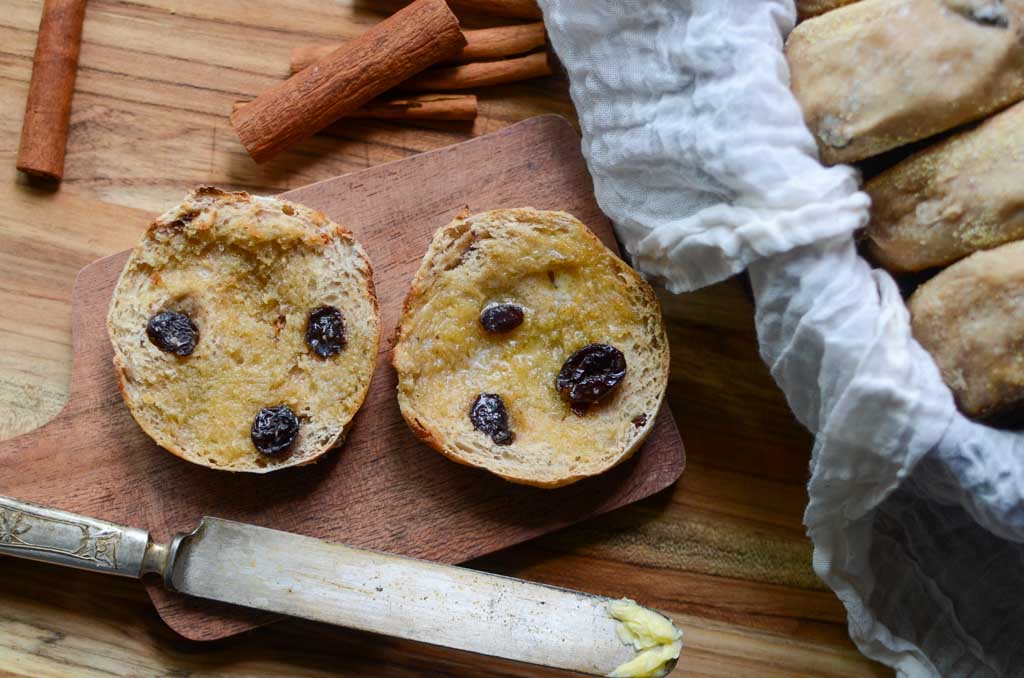
English muffins and I have a long, memorable history as they were my go-to breakfast for my last two pregnancies. I’d toast them until the edges were crispy with just a bit of char and slather them in loads of peanut butter. Sometimes I’d change it up and use cream cheese, but peanut butter was always my favorite. There’s something about it melting into the crevices and dripping as you take each bite. While messy, I loved them.
Lately, I’ve been on a cinnamon kick. Sourdough cinnamon rolls, sourdough cinnamon sugar quick bread, and cinnamon sugar pull-apart bread have been a staple in my kitchen of late. Taking my love of English muffins and keeping with the theme, I knew that a cinnamon raisin version would be next on my list to make. Needless to say, they are delicious! My family loves them and I hope you do too!
Sourdough Cinnamon Raisin English Muffin Dough Ingredients
- Sourdough Starter – An active sourdough starter is what gives the cinnamon raisin English muffins their lift. Use an active starter, meaning that it has been fed recently with flour and water, and has risen to its peak. At this point, the starter is ready to use in the recipe.
- Raisins – Raisins have a spectrum of how dry they are. Soaking them in water provides a consistent level of hydration without affecting the ratios in the dough.
- Water – I always use warm water when making sourdough, giving the yeast a head start to grow.
- Butter – Use salted melted butter.
- Brown sugar – Adds just a touch of sweetness to complement the raisin and cinnamon flavors.
- Cinnamon – Use ground cinnamon
- Salt – Adds flavor to the English muffins. Add an additional 1/4 tsp if using unsalted butter.
- Flour – I use bread flour because I like the chewy texture it gives the English muffins. I’ve used all-purpose flour in the past with excellent results.
How to Make Sourdough Cinnamon Raisin English Muffins
Prepare
Feed the sourdough starter and allow it to come to its peak with plenty of bubbles and activity.
Place raisins in a small bowl and fill with warm water, covering the raisins. Allow to soak for 30 minutes to plump up.
Mixing the Dough
Add melted butter, water, sourdough starter, brown sugar, cinnamon, and salt to a large bowl.
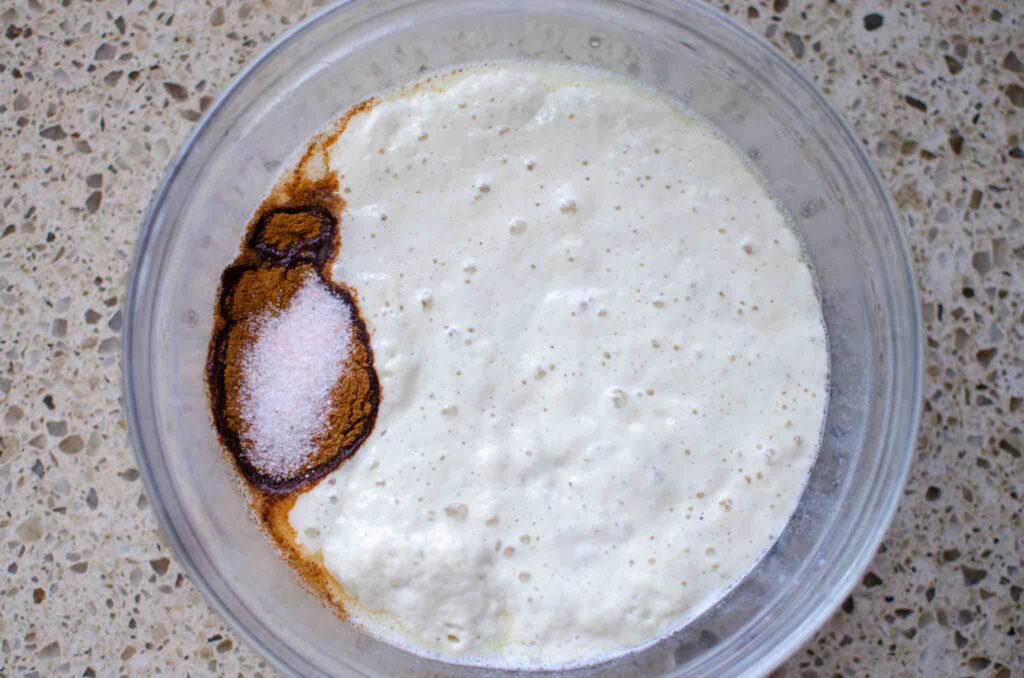
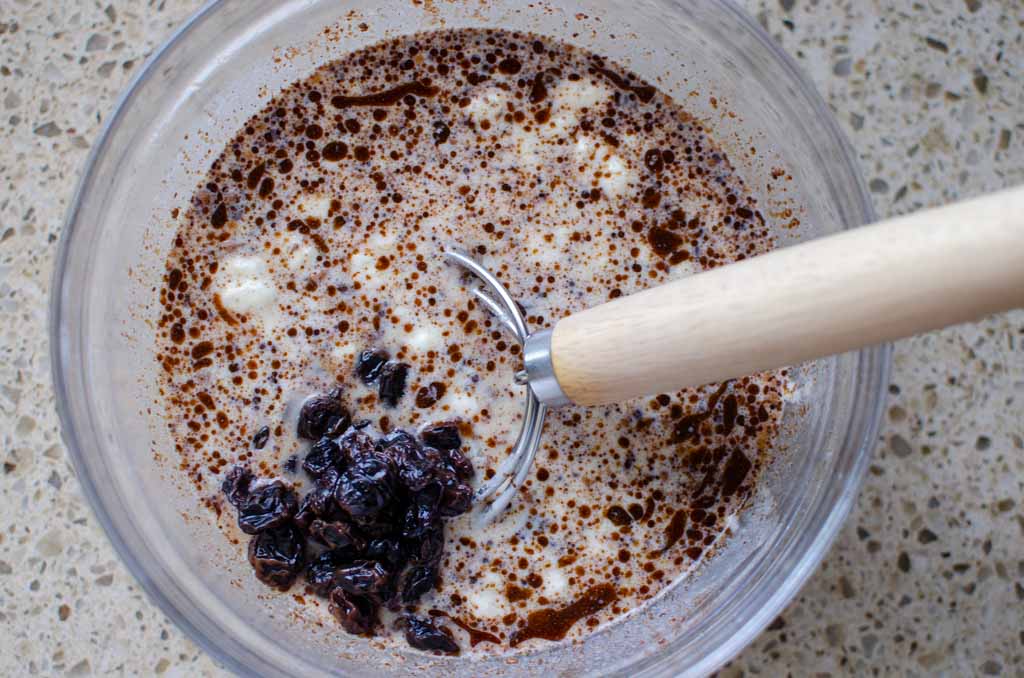
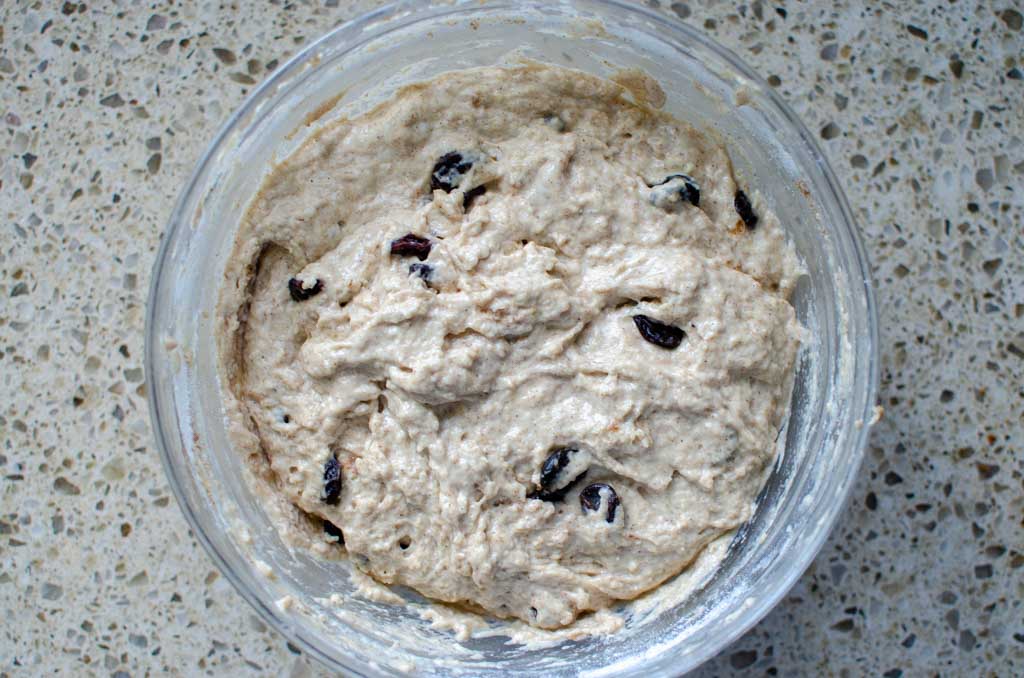
Drain the water from the raisins and place them on a paper towel so they’re not soaking wet. Add to the bowl and combine all of the ingredients. Next, add the flour and stir to mix in. At this point, the dough is shaggy and will break easily as you stretch it.
Cover the bowl and allow to rest for 30 minutes. This gives some time for the flour to properly hydrate and the gluten strands begin to form.
Uncover the bowl and do a series of stretch and folds. Grab the side of the dough and lift it straight up, stretching the dough. Then fold it over onto itself into the middle of the dough. Rotate the bowl a quarter of a turn and do another stretch and fold. Continue working your way around the sides of the bowl, stretching and folding the dough 10-12 times.
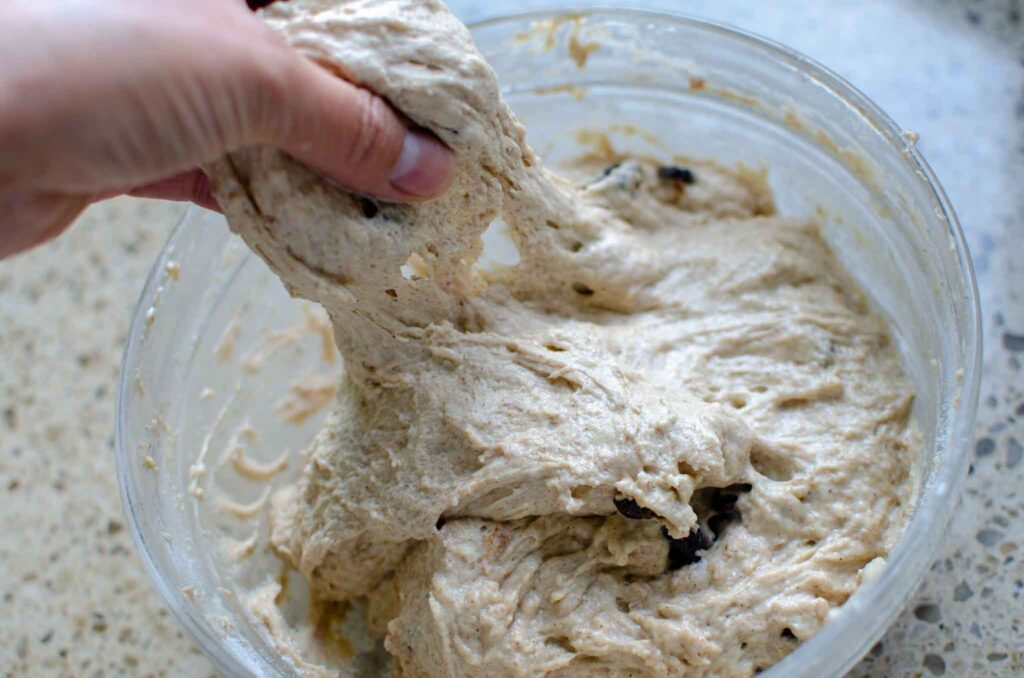
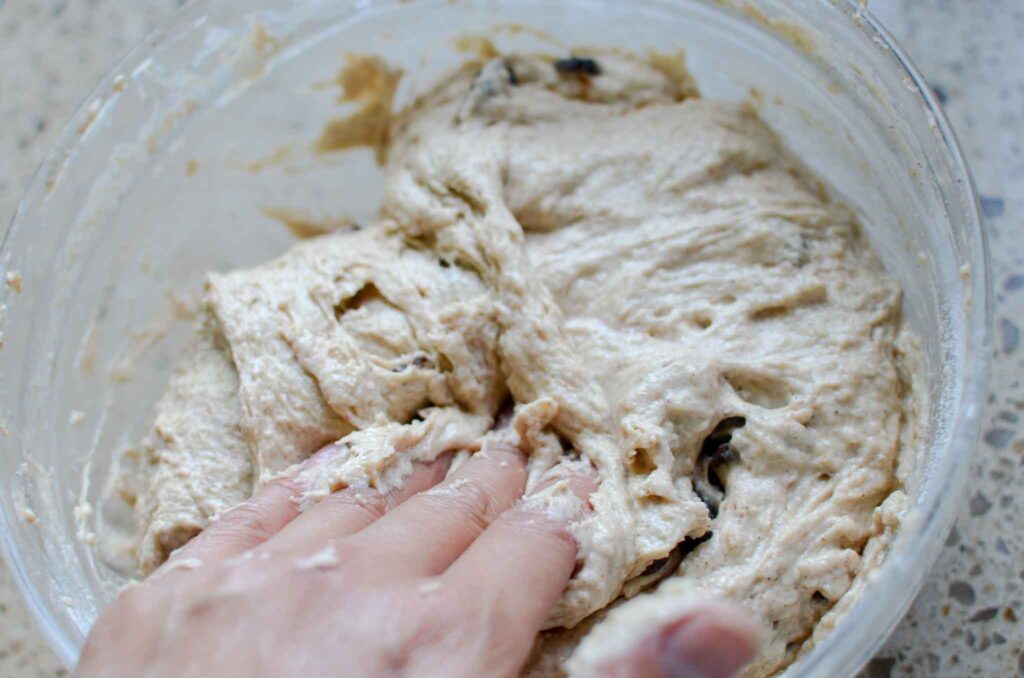
Bulk Fermentation
Cover the bowl and let it sit at room temperature, preferably in a warm place, for 8-12 hours or overnight. You will notice the top of the dough will have grown, looking soft and puffy by the end of the fermentation process. A visual sign that the good bacteria have done their job.
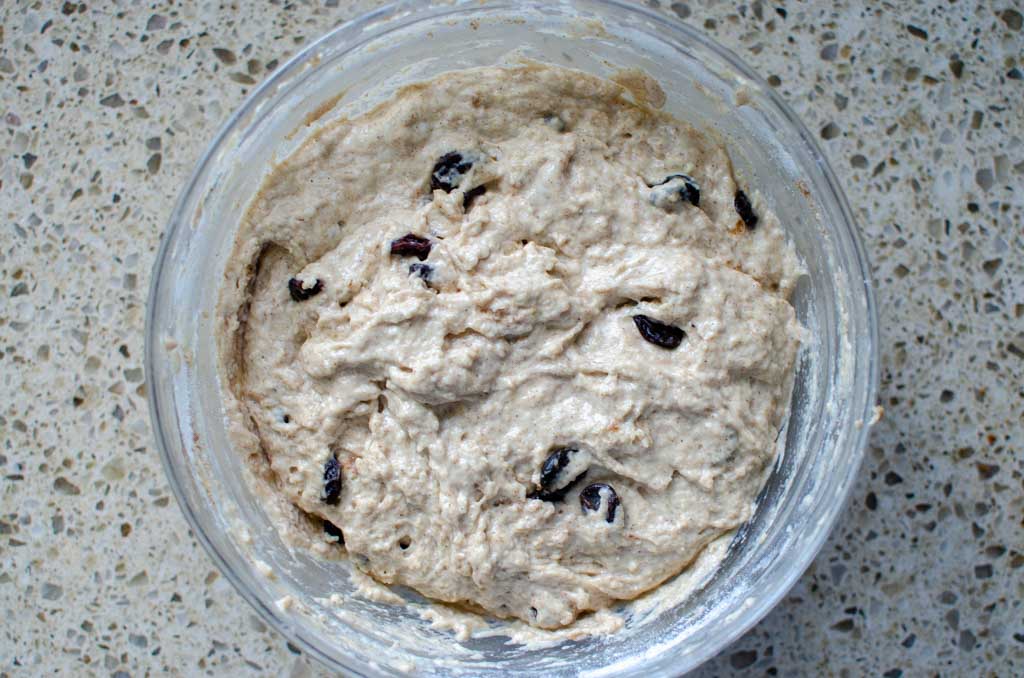
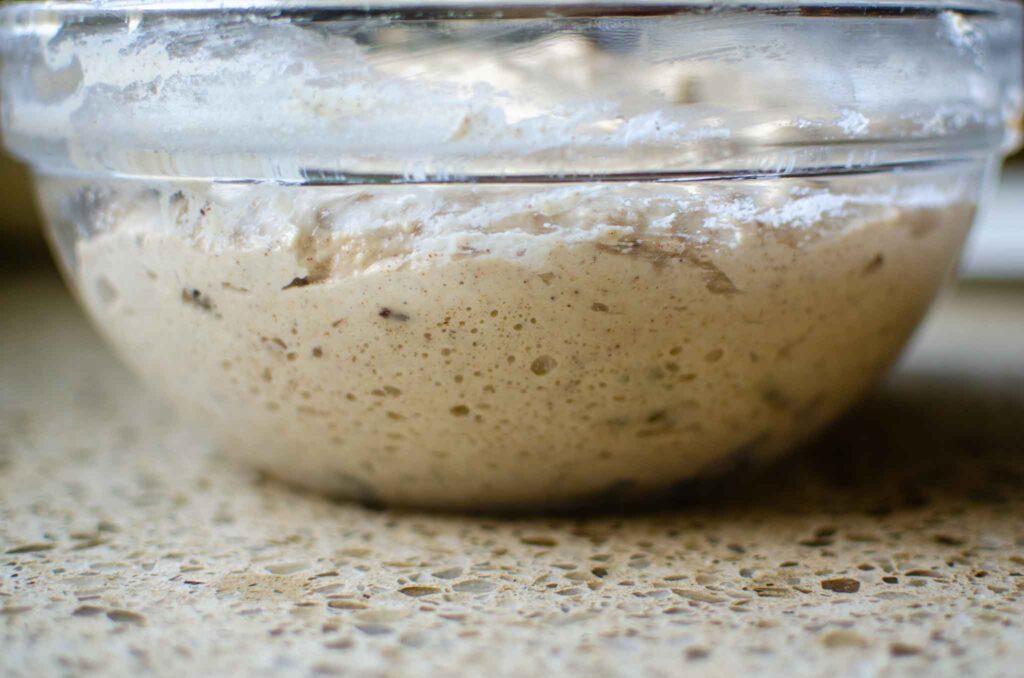
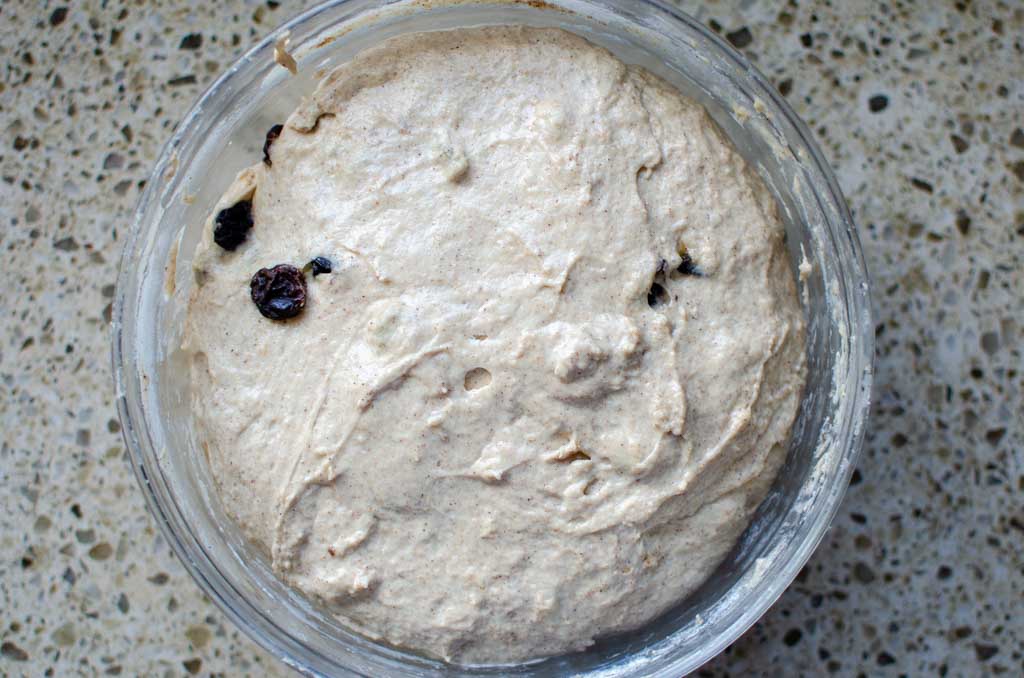
Shape and Second Rise
The next day turn out the dough onto a lightly floured surface.
Line a baking sheet with a piece of parchment paper and dust with cornmeal.
Divide the dough into 12 equal parts using a bench scraper. This is a soft, sticky dough so use flour as you need when shaping the dough.
Roll each portion of dough into a ball, gathering and pinching the seams together. Place onto the parchment paper, leaving enough space between each to rise. After shaping all 12 pieces of dough, cover them with a tea towel or plastic wrap. Let the dough rest for 1-2 hours until the muffins have puffed up and spread a bit.
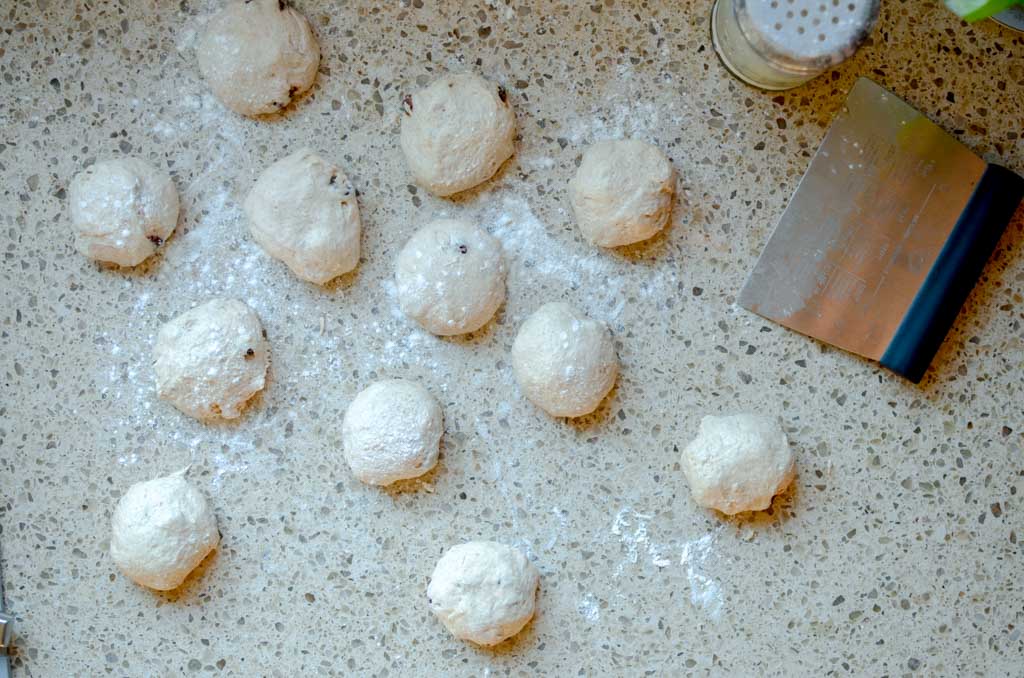
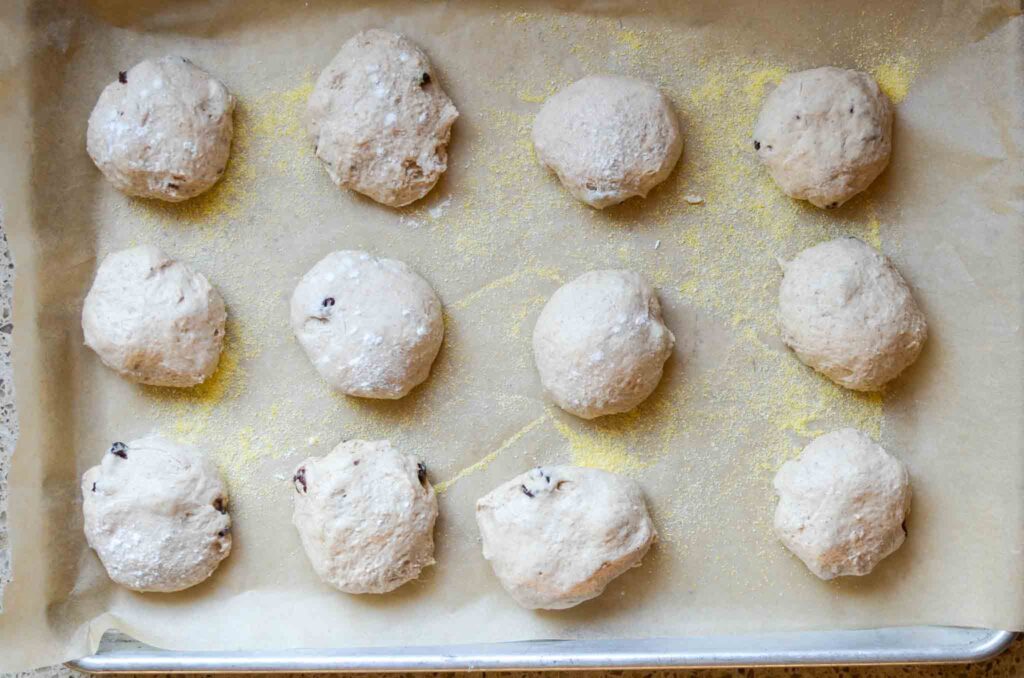
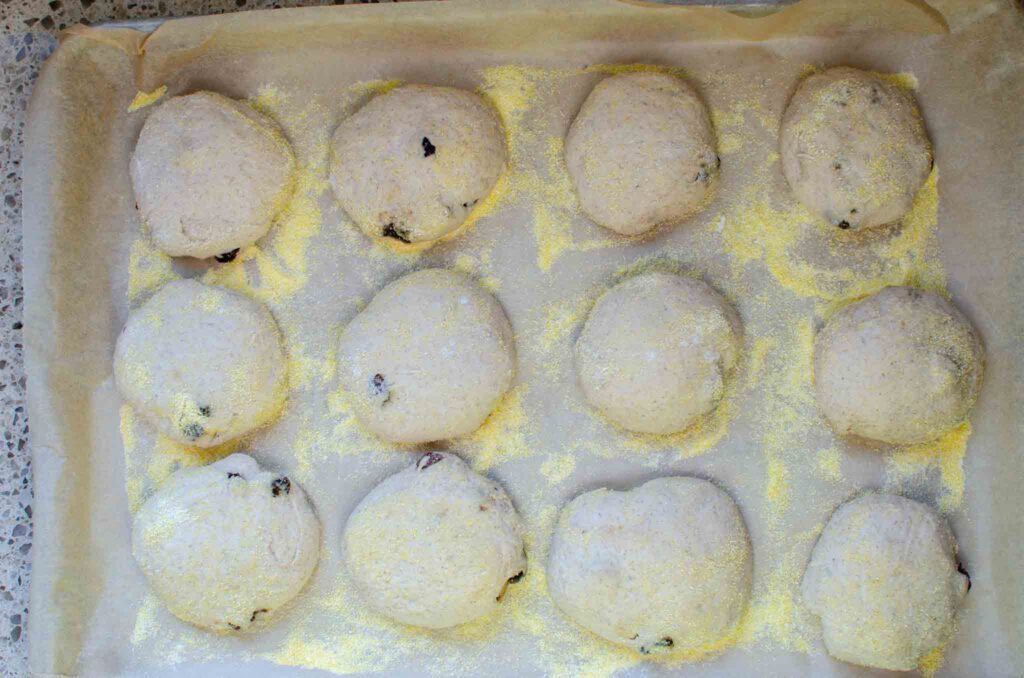
Cook
When it comes to cooking sourdough English muffins, low and slow is key.
Preheat a heavy-bottomed skillet or griddle over medium heat on the stove. I use a cast iron skillet or griddle. After 3-5 minutes the pan should be ready. Reduce the stove to low heat and place the English muffins onto the pan, giving a bit of space between them as they cook.
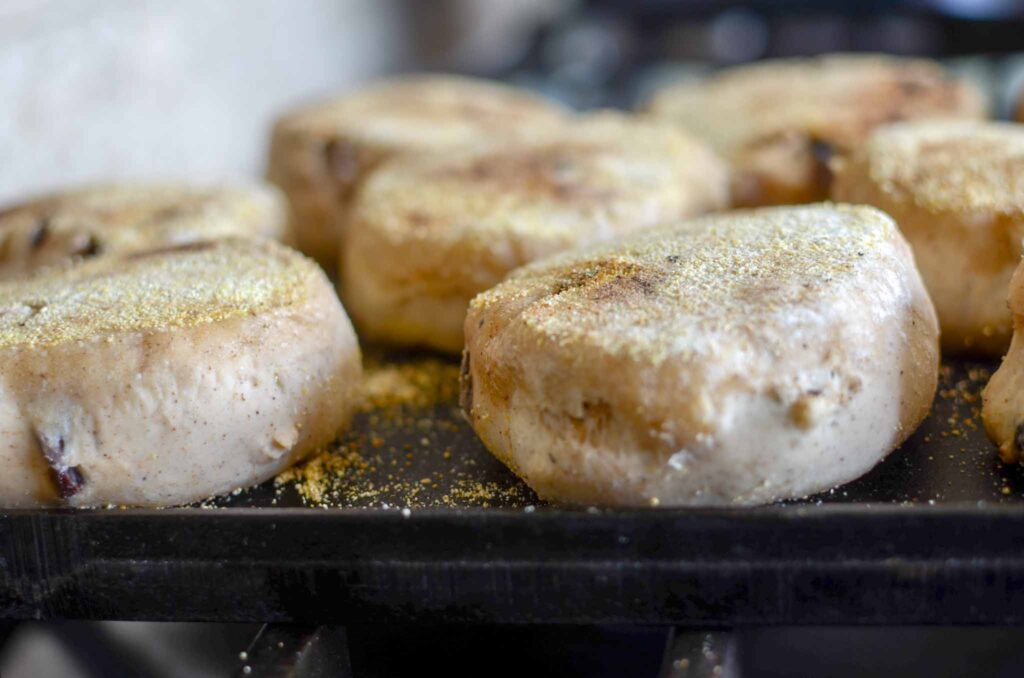
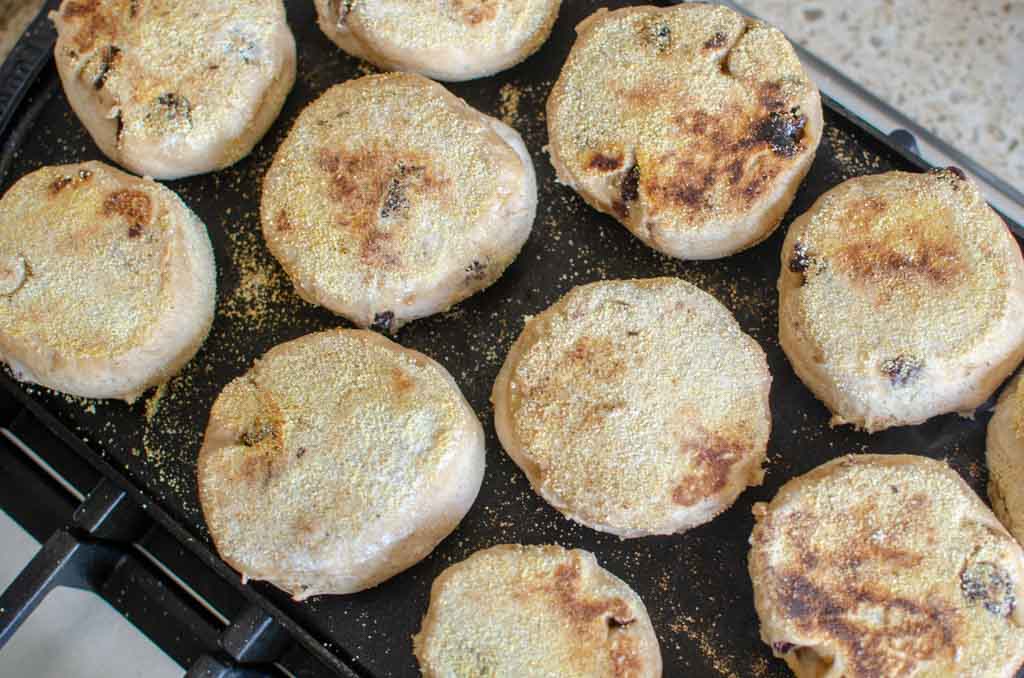
Cook for 8 minutes on one side. Flip and continue to cook for an additional 8 minutes. As the muffins cook, you’ll notice the side of the muffin go from glossy to matte as they cook and the bottoms turn golden brown.
Check every few minutes that the bottoms aren’t getting too dark. You may need to rotate where the muffins are if there are hot spots in the pan.
The muffins are done when a digital thermometer inserted into the middle reads 200 degrees. Due to varying temperatures of stoves, the exact timing may be off slightly from mine. Using a digital thermometer is the best way to know when they’re done.
Remove the cinnamon raisin English muffins from the stove and place on a wire rack to cool.
Storage
Allow the English muffins to cool completely and place them into an airtight container or a plastic bag. Store at room temperature for up to 3 days. Refrigerate for longer storage.
To freeze English muffins, allow the muffins to cool to room temperature and place them into a freezer bag, squeezing out as much air as possible. Label with the name and date and place into the freezer. For the best flavor use within 3 months.
Ways to Enjoy Sourdough Cinnamon Raisin English Muffins
- Slicing them in half and toasting them is a must! The cinnamon flavor shines and the raisins roast while the edges get crispy and the center remains soft.
- Top with butter and a drizzle of honey or your favorite jam for a morning breakfast or an afternoon snack.
- Spread each half with a generous amount of cream cheese.
- Toast and melt a smear of cinnamon honey butter on each half.
I’d love to hear from you! Please leave a comment and rate the recipe. Tag photos #Lockremhomestead over on Instagram when you share pictures of your Sourdough Cinnamon Raisin English Muffins!

Sourdough Cinnamon Raisin English Muffin Recipe
Want to Save This Recipe?
Enter your email & I’ll send it to your inbox. Plus, get great new recipes from me every week!
By submitting this form, you consent to receive emails from Lockrem Homestead
Ingredients
- 120 g raisins, measure before soaking ¾ cup
- 250 g active sourdough starter 1 cup
- 240 g warm water 1 cup
- 25 g light or dark brown sugar 2 tbsp
- 1 tbsp ground cinnamon
- 28 g salted butter, melted 2 tbsp
- 375 g bread flour 3 cups
Instructions
Prepare
- Feed the sourdough starter and allow it to come to its peak with plenty of bubbles and activity.
- Place raisins in a small bowl and fill with warm water, covering the raisins. Allow to soak for 30 minutes to plump up.
Mixing the Dough
- Add melted butter, water, sourdough starter, brown sugar, cinnamon, and salt to a large bowl.
- Drain the water from the raisins and place them on a paper towel so they're not soaking wet. Add to the bowl and combine all of the ingredients. Next, add the flour and stir to mix in. At this point, the dough is shaggy and will break easily as you stretch it.
- Cover the bowl and allow to rest for 30 minutes. This gives some time for the flour to hydrate as the gluten strands begin to develop.
- Uncover the bowl and do a series of stretch and folds. Grab the side of the dough and lift it straight up, stretching the dough. Then fold it over onto itself into the middle of the dough. Rotate the bowl a quarter of a turn and do another stretch and fold. Continue working your way around the sides of the bowl, stretching and folding the dough 10-12 times.
Bulk Fermentation
- Cover the bowl and let it sit at room temperature, preferably in a warm place, for 8-12 hours or overnight. You will notice the top of the dough will have grown, looking soft and puffy by the end of the fermentation process. A visual sign that the good bacteria have done their job.
Shape and Second Rise
- The next day turn out the dough onto a lightly floured surface.
- Line a baking sheet with a piece of parchment paper and dust with cornmeal.
- Divide the dough into 12 equal parts using a bench scraper. This is a soft, sticky dough so use flour as you need when shaping the dough.
- Roll each portion of dough into a ball, gathering and pinching the seams together. Place onto the parchment paper, leaving enough space between each to rise.
- After shaping all 12 pieces of dough, cover them with a tea towel or plastic wrap. Let the dough rest for 1-2 hours until the muffins have puffed up and spread a bit.
Cook
- Preheat a heavy-bottomed skillet or griddle over medium heat on the stove. I use a cast iron skillet or griddle. After 3-5 minutes the pan should be ready. Reduce the stove to low heat and place the English muffins onto the pan, giving a bit of space between them as they cook.
- Cook for 8 minutes on one side. Flip and continue to cook for an additional 8 minutes. As the muffins cook, you'll notice the side of the muffin go from glossy to matte as they cook and the bottoms turn golden brown.
- Check every few minutes that the bottoms aren't getting too dark. You may need to rotate where the muffins are if there are hot spots in the pan.
- The muffins are done when a digital thermometer inserted into the middle reads 200 degrees. Due to varying temperatures of stoves, the exact timing may be off slightly from mine. Using a digital thermometer is the best way to know when they're done.
- Remove the cinnamon raisin English muffins from the stove and place on a wire rack to cool.
Storage
- Allow the English muffins to cool completely and place them into an airtight container or a plastic bag. Store at room temperature for up to 2 days. Refrigerate for longer storage.
- To freeze English muffins, allow the muffins to cool to room temperature and place them into a freezer bag, squeezing out as much air as possible. Label with the name and date and place into the freezer. For the best flavor use within 3 months.

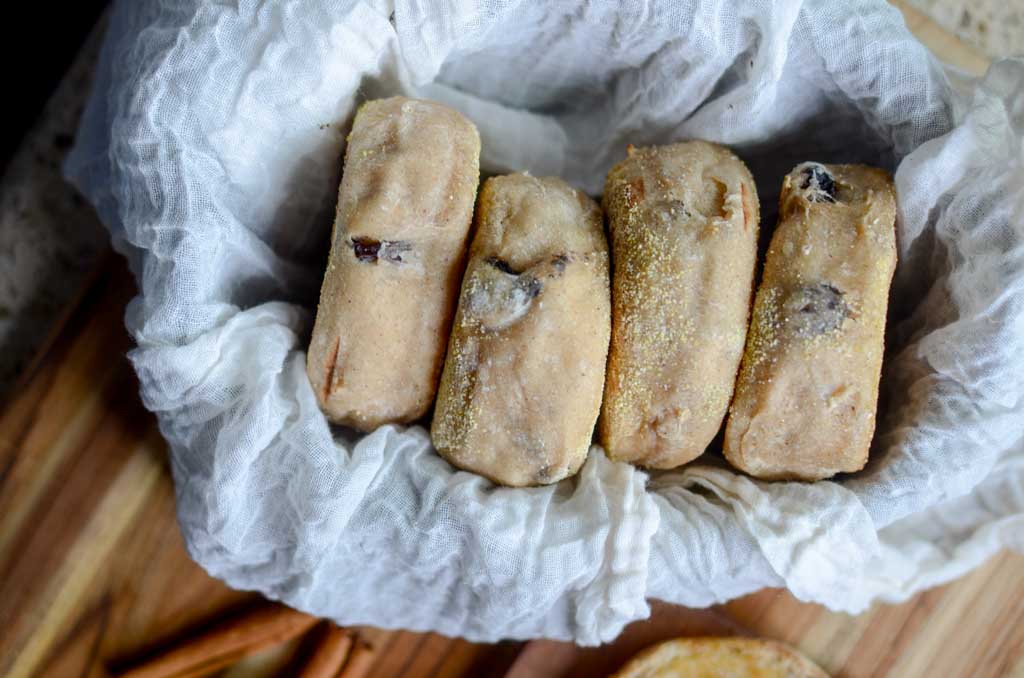
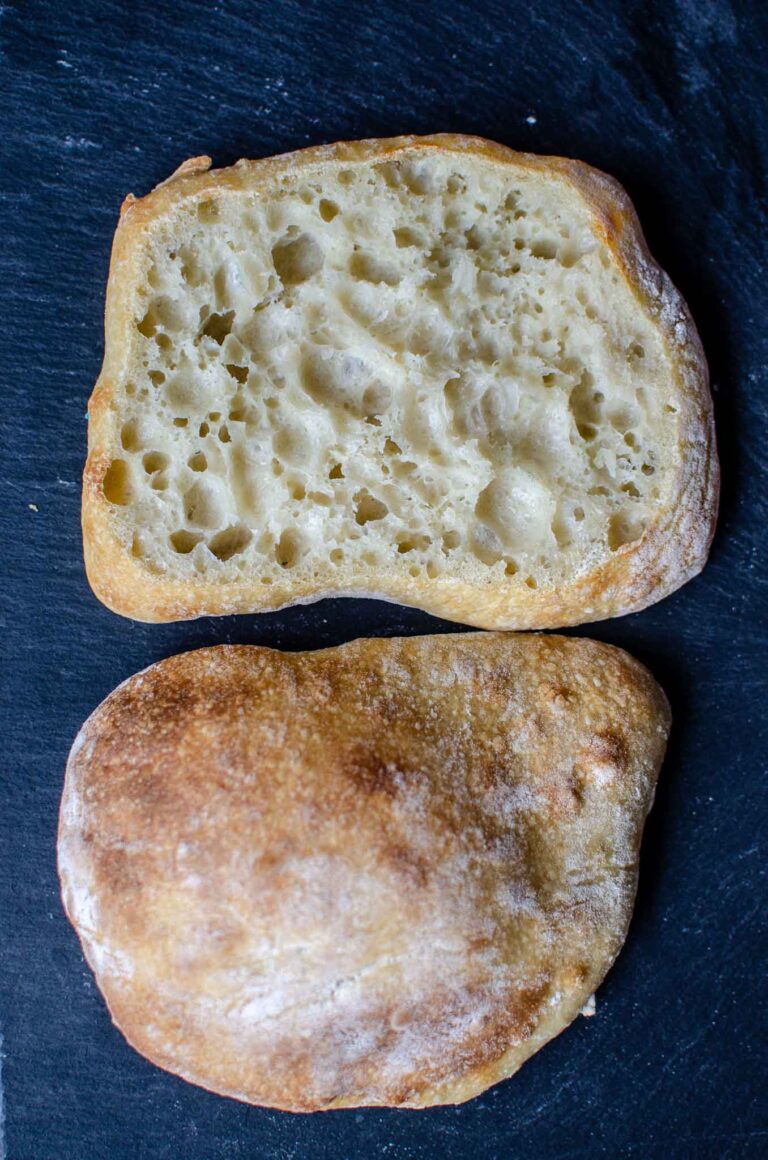
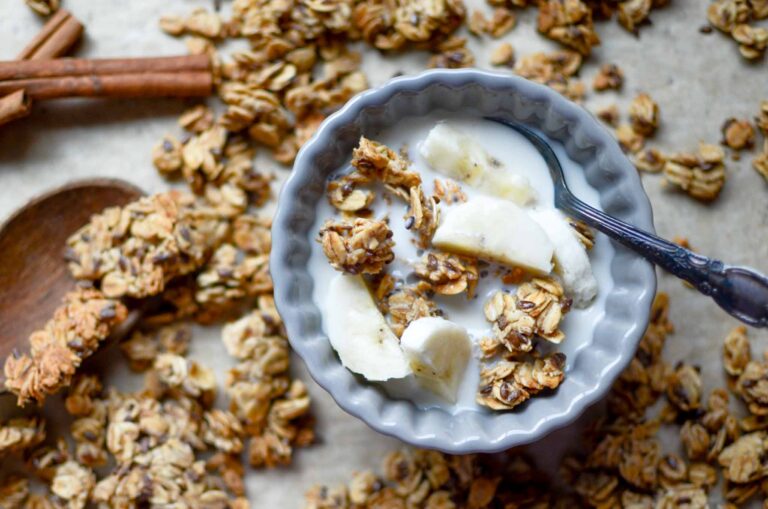

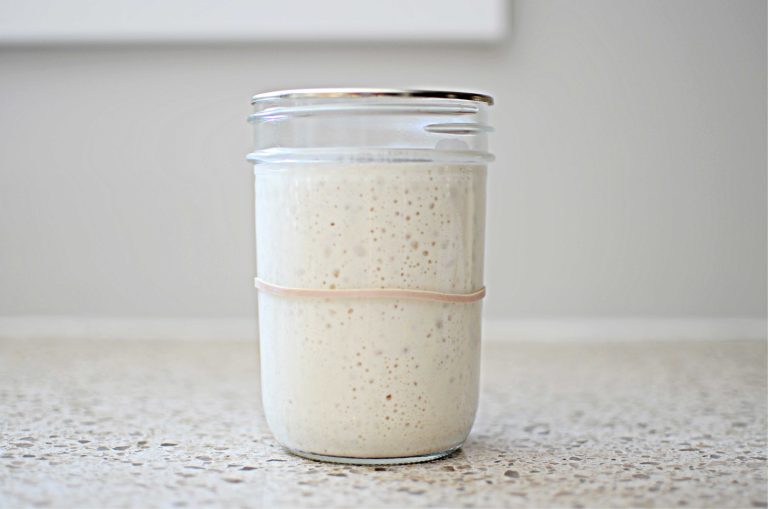
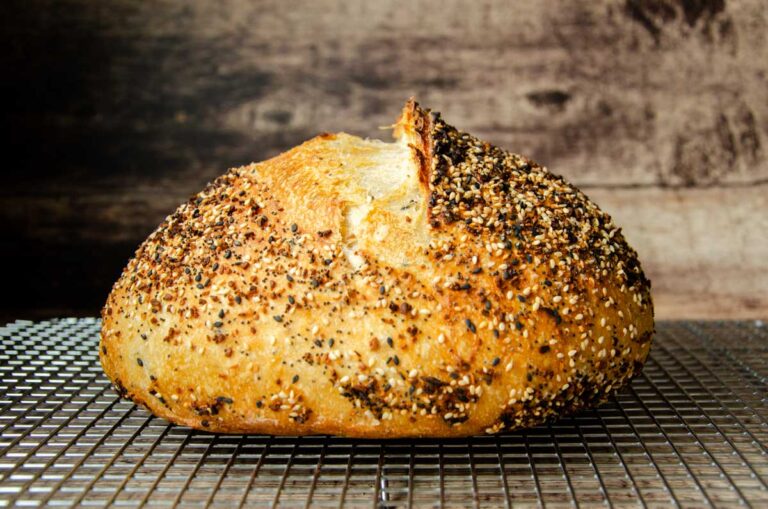

I know you’re going to LOVE this recipe! It’s one of our family favorites. Plus, don’t forget that you can leave a comment or ask me a question here, and I’ll get back to you!